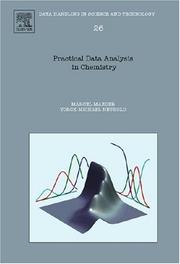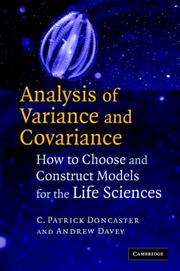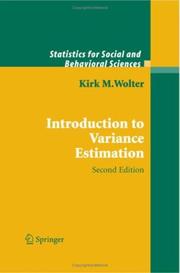| Listing 1 - 3 of 3 |
Sort by
|

ISBN: 1281119903 9786611119904 0080548830 0444530541 9780444530547 9780080548838 Year: 2007 Publisher: Amsterdam ; Boston : Elsevier,
Abstract | Keywords | Export | Availability | Bookmark
 Loading...
Loading...Choose an application
- Reference Manager
- EndNote
- RefWorks (Direct export to RefWorks)
The majority of modern instruments are computerised and provide incredible amounts of data. Methods that take advantage of the flood of data are now available; importantly they do not emulate 'graph paper analyses' on the computer. Modern computational methods are able to give us insights into data, but analysis or data fitting in chemistry requires the quantitative understanding of chemical processes. The results of this analysis allows the modelling and prediction of processes under new conditions, therefore saving on extensive experimentation. Practical Data Analysis in Chemistry exe
Analysis of variance. --- Chemistry --- Statistical methods. --- ANOVA (Analysis of variance) --- Variance analysis --- Mathematical statistics --- Experimental design

ISBN: 9780521684477 9780511611377 9780521865623 9780511355936 0511355939 0511354916 9780511354915 0511611374 1281153729 9781281153722 052186562X 0521684471 1107178754 9786611153724 0511355432 0511354339 0511573359 Year: 2007 Publisher: Cambridge Cambridge University Press
Abstract | Keywords | Export | Availability | Bookmark
 Loading...
Loading...Choose an application
- Reference Manager
- EndNote
- RefWorks (Direct export to RefWorks)
Analysis of variance (ANOVA) is a core technique for analysing data in the Life Sciences. This reference book bridges the gap between statistical theory and practical data analysis by presenting a comprehensive set of tables for all standard models of analysis of variance and covariance with up to three treatment factors. The book will serve as a tool to help post-graduates and professionals define their hypotheses, design appropriate experiments, translate them into a statistical model, validate the output from statistics packages and verify results. The systematic layout makes it easy for readers to identify which types of model best fit the themes they are investigating, and to evaluate the strengths and weaknesses of alternative experimental designs. In addition, a concise introduction to the principles of analysis of variance and covariance is provided, alongside worked examples illustrating issues and decisions faced by analysts.
Biometry. --- Analysis of variance. --- Analysis of variance --- Biometry --- Biological statistics --- Biology --- Biometrics (Biology) --- Biostatistics --- Biomathematics --- Statistics --- ANOVA (Analysis of variance) --- Variance analysis --- Mathematical statistics --- Experimental design --- Statistical methods

ISBN: 1280970014 9786610970018 0387350993 038732917X 9780387329178 1441921974 Year: 2007 Publisher: New York : Springer,
Abstract | Keywords | Export | Availability | Bookmark
 Loading...
Loading...Choose an application
- Reference Manager
- EndNote
- RefWorks (Direct export to RefWorks)
We live in the information age. Statistical surveys are used every day to determine or evaluate public policy and to make important business decisions. Correct methods for computing the precision of the survey data and for making inferences to the target population are absolutely essential to sound decision making. Now in its second edition, Introduction to Variance Estimation has for more than twenty years provided the definitive account of the theory and methods for correct precision calculations and inference, including examples of modern, complex surveys in which the methods have been used successfully. The book provides instruction on the methods that are vital to data-driven decision making in business, government, and academe. It will appeal to survey statisticians and other scientists engaged in the planning and conduct of survey research, and to those analyzing survey data and charged with extracting compelling information from such data. It will appeal to graduate students and university faculty who are focused on the development of new theory and methods and on the evaluation of alternative methods. Software developers concerned with creating the computer tools necessary to enable sound decision-making will find it essential. Prerequisites include knowledge of the theory and methods of mathematical statistics and graduate coursework in survey statistics. Practical experience with real surveys is a plus and may be traded off against a portion of the requirement for graduate coursework. This second edition reflects shifts in the theory and practice of sample surveys that have occurred since the content of the first edition solidified in the early 1980’s. Additional replication type methods appeared during this period and have featured prominently journal publications. Reflecting these developments, the second edition now includes a new major chapter on the bootstrap method of variance estimation. This edition also includes extensive new material on Taylor series methods, especially as they apply to newer methods of analysis such as logistic regression or the generalized regression estimator. An introductory section on survey weighting has been added. Sections on Hadamard matrices and computer software have been substantially scaled back. Fresh material on these topics is now readily available on the Internet or from commercial sources. Kirk Wolter is a Senior Fellow at NORC, Director of the Center for Excellence in Survey Research, and Professor in the Department of Statistics, University of Chicago. He is a Fellow of the American Statistical Association and a Member of the International Statistical Institute. He is a past president of the International Association of Survey Statisticians and a past chair of the Survey Research Methods Section of the American Statistical Association. During the last 35 years, he has participated in the planning, execution, and analysis of large-scale complex surveys and has provided instruction in survey statistics both in America and around the world.
Analysis of variance. --- Estimation theory. --- Estimating techniques --- Least squares --- Mathematical statistics --- Stochastic processes --- ANOVA (Analysis of variance) --- Variance analysis --- Experimental design --- Analysis of variance --- Estimation theory --- Analyse de variance --- Théorie de l'estimation --- EPUB-LIV-FT LIVSTATI SPRINGER-B --- Mathematical statistics. --- Statistical Theory and Methods. --- Mathematics --- Statistical inference --- Statistics, Mathematical --- Statistics --- Probabilities --- Sampling (Statistics) --- Statistical methods --- Statistics . --- Statistical analysis --- Statistical data --- Statistical science --- Econometrics
| Listing 1 - 3 of 3 |
Sort by
|

 Search
Search Feedback
Feedback About UniCat
About UniCat  Help
Help News
News